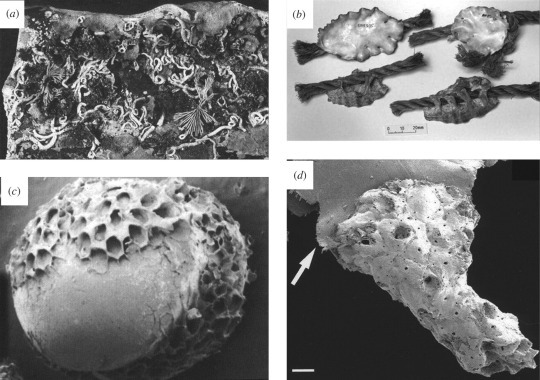Pelagic plastic items are commonly colonized by a diversity of encrusting and fouling animals. Most
Pelagic plastic items are commonly colonized by a diversity of encrusting and fouling animals. Most of these are sessile, hard-shelled or crustose organisms and dominated by moss animals (bryozoans). Also included are barnacles, tube worms, foraminifera, coralline algae, hydroids and bivalve molluscs. Aggregations of marine debris can provide habitats suiting the larval and juvenile stages of numerous marine organisms. They may also attract free-living, ocean-roaming predators that often gather under fish aggregating devices, and where others simply sought a protective haven.Example of colonization and encrustation on plastic debris from the New Zealand coastline: (a) Heavy and varied colonization of a plastic slab recovered (note the hard bodied encrustations and soft fleshy epibionts.(b) Cuttings from a tangled mass of synthetic rope, carrying a cargo of the warm-water Indo-Pacific oyster, Lopha cristagalli, a species that is alien to New Zealand waters. © Plastic pellet (raw material for manufacture of plastic products) encrusted by the bryozoan Membranipora taberculata.(d) Small bryozoan colony (Galeopsis mimicus) attached to a frayed plastic flake (arrowed) recovered from a depth of 393 m off the east coast shelf off the South Island. scale bar 0,2 mm.Reference (Open Access): Gregory, 2009. Environmental implications of plastic debris in marine settings—entanglement, ingestion, smothering, hangers-on, hitch-hiking and alien invasions. Philosophical Transactions of the Royal Society B: Biological Sciences. -- source link
Tumblr Blog : marinelitter.tumblr.com
#marine debris#marine litter#plastic debris#membranipora taberculata#galeopsis mimicus#sciblr#marine science#marine biology#biology#oceans#benthic debris#benthic litter#lopha cristagalli
